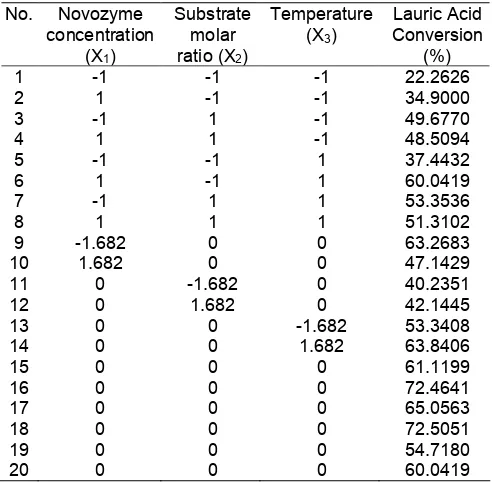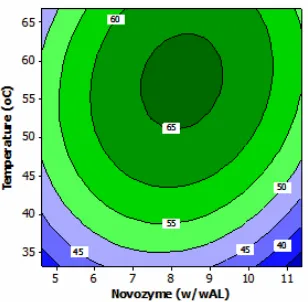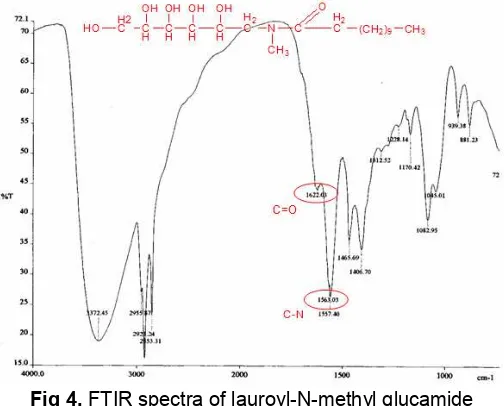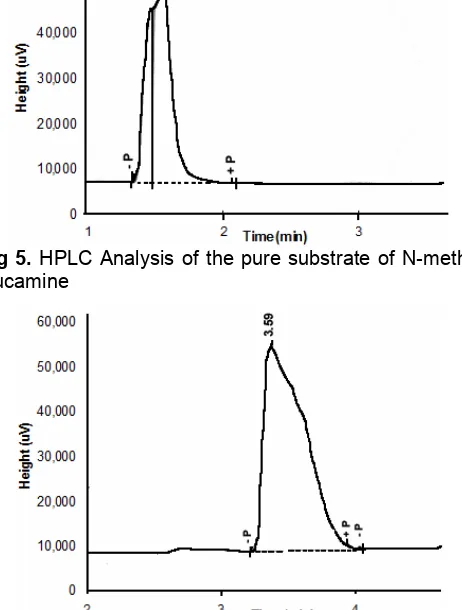THE OPTIMIZATION OF ENZYMATIC SYNTHESIS FOR LAUROYL-N-METHYL
GLUCAMIDE SURFACTANTS
Zuhrina Masyithah
1,*, Seri Bima Sembiring
2, Zul Alfian
2, and Tjahjono Herawan
31
Department of Chemical Engineering, University of North Sumatera, Jl. Almamater Kampus USU Medan 20155
2
Department of Chemistry, University of North Sumatera, Jl. Almamater Kampus USU Medan 20155
3
Indonesian Oil Palm Research Institute (IOPRI), Jl. Brigjen Katamso 51, Medan
Received February 19, 2011; Accepted October 26, 2011
ABSTRACT
The optimization of enzymatic synthesis for lauroyl-N-methyl glucamide surfactants is studied. The fraction of palm kernel oil namely lauric acid (AL) was amidificationed with N-methyl glucamine (MGL) to produce lauroyl-N-methyl glucamide. Study was carried out by using immobilized lipase from Candida antarctica (Novozyme 435®), and tert-amylalcohol as a solvent. Response Surface Methodology (RSM) based on a five level, three variable design was employed, firstly, for studying the interactive effect of various parameters on the reaction, and secondly, for the optimization. The reaction parameters observed were Novozyme concentration, substrate molar ratio, and temperature. Simultaneously increasing Novozyme concentration, substrate molar ratio, and temperature improves the reaction yield and the effect of temperature is noted more significant. The expected optimum condition was at molar ratio MGL:AL 1:1, the Novozyme concentration of 8% and the reaction temperature of 50-55 °C. The reactions at the optimum condition produce the convertion of lauric acid of 64.5% and yield of 96.5%. With the optimization procedure the higher alkyl glucamide yield was achieved.
Keywords:amidification, lauric acid, N-methyl glucamine, Response Surface Methodology
INTRODUCTION
Surfactant is the important surface active agent and it is used in huge amount today. However, since the surface active agent is known detrimental to aquatic environment, the biodegradable and biocompatible surfactants are preferred. The researcher attempts to solve this problem by using the enzyme as a catalyst to produce alkanolamide [1-2] Enzymatic synthesis of lauroyl-N-methyl glucamide is an interesting alternative to produce the biodegradable and biocompatible surfactants. The lauroyl-N-methyl glucamide could be obtained from amidification reaction between amine and fatty acid from natural oil using enzyme as biocatalyst [3].
The enzymatic approach presents several advantages, such as there are no by-product and no need for protection/deprotection of the reagent, the enzymes are regio, stereo and chemoselective [4] and could work at the lower temperature [5]. Lipase chemoselectivity on alkanolamide synthesis was observed. It was obtained that lipase could be used in acylation, not only amine bond but also alcohol bond [6-7]. Lipases are a special type of enzymes that catalyse the hydrolysis of oils and fats. They function at the water-oil interface. Therefore, high interfacial area between oil and the aqueous phase, which contains the enzyme, should enhance the rate of hydrolysis [8]
Mostly lipase catalyse amidification reaction and esterification reaction of alkanolamine; however, if the final product expected is amide, the reaction for ester must be controlled and acyl migration from alcohol to amine must increase the alkanolamide production. The weakness on enzymatically production of biosurfactants is that the yield is too low for development at the industrial level [9]. In fact, for biocatalyst to be competitive, the surfactants must be produced at low cost, preferably from cheap, renewable material and effort must be paid for optimization the yield.
The classical method of optimization involves changing one variable at a time, keeping the others at fixed levels. Being single dimensional, this laborious and time consuming method often does not guarantee determination of optimal conditions. On the other hand carrying out experiments with every possible factorial combination of the test variables is impractical because of the large number of experiments required [10].
2 1 -1 -1 34.9000
optimum of the enzymatic synthesis of surfactant were Hamsaveni et al. [11], Krishna et al. [12], Ee Lin Soo et al. [13], Ramkrishna and Swaminathan [14], and Rodrigues et al. [10].
For the purpose, the present study is aimed to obtain the optimum condition using Response Surface Methodology on amidification enzymatic reaction in order to produce lauroyl-N-methyl glucamide surfactants from N-methyl glucamine with lauric acid, catalyzed by immobilized lipase in organic solvent.
The lauric acid was selected as the source of fatty acid since the amide from lauric acid was widely used for same cosmetic and drug products [15]. While the N-methyl glucamide could be obtained from the renewable resources [16] and the fatty acid surfactant N-methyl glucamide resulted was one of the sugar based surfactants which significantly maker demanded [17].
EXPERIMENTAL SECTION
Materials
Novozyme 435 (lipase from Candida antarctica
immobilised on an acrylic resin) was from Novo
Procedure
Optimization step
The lauric acid and N-methyl glucamine was carried out with Novozyme in tert-amylalcohol for reaction time of 48 h at an orbital shaking speed of 250 rpm. The variable observed is Novozyme concentration, substrate molar ratio and temperature, with the respond is conversion of fatty acid.
The experiment was designed by Central Composite Design (CCD) with five levels and three variables. Response Surface Methodology (RSM) was utilized to observe the individual and interaction effect and to optimize the effect of variable observed to obtain the maximum conversion of fatty acid [18]. The center point in CCD shows the value of the best conversion in the preliminary step observation [19]. The indicator for the best value is based on the magnitude of fatty acid conversion in the reaction. Fatty acid conversion is obtained from the following equation:
initial end
initial
acid value - acid value
% conversion =
acid value (1)
Data recorded from the experiment were analyzed by multiple regression method to generate the third order polynomial as shown in the following equation:
where y is the response variable (% conversion), b the constant, bi the linear coefficient, bii the quadratic
coefficient, biiithe cubic coefficient, and bijthe diagonal
coefficient.
Purification
Fig 1. The contour of response plot of Novozyme concentration and molar ratio of MGL/AL on lauroyl-N-methyl glucamide
Fig 2. The contour of response plot of Novozyme
concentration and temperature on lauroyl-N-methyl glucamide synthesis
with acetone as the upper product.
FTIR Analysis
Infra red spectra were recorded using a Perkin Elmer 1000 spectrometer for KBr pellets.
HPLC Analysis
Quantitative analysis was obtained by Perkin Elmer High Performance Liquid Chromatography (HPLC) 200. The lauric acid and N-methyl glucamine are pure substrate and indeed its standard retention time can be obtained. The composition of lauroyl-N-methyl glucamide product is obtained from the different time retention of lauroyl-N-methyl glucamide to the time retention of both substrates.
Referring to the result of Par Tufvesson et al. [9], the product composition of amide synthesis from fatty acid and amine could be obtained using Supelcosil LC 18, 5m (250 x 4.6 mm) column at flow rate 0.7 mL/min. 25 µL of the proper dilution of the reaction mixture were injected. For reaction with long-chain fatty acids (more than 12 carbon atoms), a mixture of methanol:water:TFA, 90:10:0.3 (v/v/v) was used as eluent at 40 °C. For reaction with short-chain fatty acids (less than 12 carbon atoms), a mixture of methanol:water:TFA, 80:20:0.3 (v/v/v) was used as eluent at 40 °C. With lauric acid and N-methyl glucamine reaction, a mixture of methanol:water:TFA, 80:20:0.3 (v/v/v) was used as eluent at 40 °C and a flow rate of 0.7 mL/min. The retention time of substrate was analyzed and compared to the retention time of product.
RESULT AND DISCUSSION
The lauroyl-methyl glucamide synthesis from N-methyl glucamine and lauric acid amidification is chosen as a reaction model. The two substrates of the reaction are molecules with different polarities and solubilities.
Fatty acid is soluble in hydrophobic solvents while N-methyl glucamine is poorly soluble in such solvents.
RSM analysis was carried out using commercial software. The relation among coefficients for each variable and the variable interaction, with response is lauric acid conversion is as shown in Equation (3).
1 2 3
The quadratic model is plotted as a contour response plots to expresses the lauric acid conversion.
The effect of enzyme concentration and substrate molar ratio
Fig. 1 shows the contour of response plot when observing the effect of enzyme concentration and substrate molar ratio of MGL/AL on fatty acid conversion. The observation shows that lauric acid conversion increases as the increasing of enzyme concentration and substrate molar ratio up to a certain level.
This contour expresses that the increasing of lauric acid conversion is steeper than the increasing of substrate molar ratio of MGL/AL when comparing based on the result of enzyme concentration. The increasing of substrate molar ration is affected the increasing of mixture concentration. At high level substrate concentration, the probability of impact between particles is high; as a result, the probability of amidification reaction is higher.
Fig 3.The contour of response plot of temperature and molar ratio of MGL/AL on lauroyl-N-methyl glucamide synthesis
Fig 4.FTIR spectra of lauroyl-N-methyl glucamide
usage of amine molar ratio higher than level 0 (center point) both at low and high level enzyme concentration, the lauric acid conversion are decreased.
The effect of enzyme type and concentration was studied by Maugard et al. [3], Infante et al. [20], and Sharma et al. [15]. The opposite result to the present study reported by Maugard et al. [3] when N-alkyl-N-methyl glucamide synthesis from oleic acid and N-N-alkyl-N-methyl glucamine. It was reported that the optimum molar ratio of N-methyl glucamine/oleic acid is 1/3 and the use of excess oleic acid resulted the more solubility of amine thru the formation of ion pair complex with lauric acid and thus yield is increased.
The effect of enzyme concentration and temperature
The observation on the effect of enzyme concentration and temperature on lauric acid conversion is shown in Fig. 2. It can be seen that the temperature
significantly. Under this condition, it can be concluded that lipase is inactive at temperature level >60 °C. Moreover, the result expresses that temperature may accelerate the activity of lipase on amidification reaction.
The effect of temperature and substrate molar ratio
At the high level temperature of contour response shown in Fig. 3, the production of lauric acid conversion is increased as the increasing of molar ratio of MGL/AL. The contour response shows that the maximum product yield can be obtained when temperature variable is designed at 50 °C and level of molar ratio MGL/AL 1/1 until 2/1. At these conditions, the conversion can be gained up to 64%. When comparing to temperature, substrate molar ratio gives more significant effect on amide formation.
At the temperature of 55 °C, the initial increasing of molar ratio increases yield significantly but it has opposite meaning at the final. This condition is related to the distortion of product formation. The distortion is due to the enzyme activity which directly effected by substrate and product concentration in micro enzyme environment [21]. In this condition, the distortion occurs because the space of active enzyme which related to the substrate has been fully occupied. As a result, enzyme is unable to synthesize the substrate.
Fig 5.HPLC Analysis of the pure substrate of N-methyl glucamine
Fig 6.HPLC Analysis of the product of lauroyl-N-methyl
glucamide
Maugard et al [3] reported that alkanolamine was poorly soluble in hydrophobic solvent like n-hexane but in the present of fatty acid, alkanolamine could be soluble by ion pair complexion; and the solubility increased as the increasing of acid/amine ratio. Unfortunately, the excess acid promotes ester formation. Therefore, the molar ratio of amine/acid is determined to represent the best compromise between amidification yield and chemoselectivity.
Moreover, under the same condition, but lauric acid was replaced by FAME, it was found that the decrease of fatty acid methyl ester concentration was seen to be concominant with the synthesis of products. During the first hour, amide and ester were synthesized. Then the ester produced during the first hour of reaction completely disappeared at the end of the reaction. At the same time, new products were synthesized with 10% of yield, and were identified as amide-ester, probably formed from esters. After 10 hours of reaction, 100% of the fatty acid methyl esters was completely transformed. In these conditions a mixture of surfactants was obtained containing 75% (w/w) of amides, 15% (w/w) of
amide-esters and 10% (w/w) of N-methyl glucamine. In these proportions, for industrial preparations, the separation of the different compounds is not necessary and the mixture can be used directly as cosmetic formulations [3]. From both fatty acid substrate used in this study, fatty acid methyl esters is more efficient when used as the acyl donor, yet lauric acid also gives the good conversion.
The results of FT-IR and HPLC analysis
Analysis using spectrophotometer FTIR (Fourier Transform-Infra Red) at the optimum condition is shown in Fig. 4. The peak of absorbance is obtained at 3372.45 cm-1for OH bond. This OH is supported by OH bend at 1406.7 cm-1. CH sp3 vibration is obtained at 2923.24 cm-1 and 2853.31 cm-1 and supported by the absorbance at 1465.69 cm-1for CH sp3bend. Spectrum at 721.55 cm-1is a (CH2)n rocking for n>4. Vibration of
C=O bond occurs at 1622.03 cm-1and 1557.4 cm-1and it is a specific peak for C=O as an amide bond. The C-N is obtained at 1082.95 cm-1, while the peak of amine ester at 1700 cm-1is not formed.
The analysis using HPLC for the pure substrate of N-methyl glucamine is shown in Fig. 5 and product at the optimum condition is shown in Fig. 6. The analysis is carried out to study the composition of the product. The standard of substrate and product are determined through the difference of retention time between substrate and product. It is possible to do because the substrate is almost pure (>99%). The results on HPLC show the lauric acid and N-methyl glucamine appear at the retention time around 7 to 8.5 min and 1.5 to 1.6 min, respectively. Product is lauroyl-N-methyl glucamine with retention time around 3.5 to 4.4 min. For some samples, at the retention time of 4.8 min amide-ester namely N-O-dilauroyl-n-methyl glucamine is also observed. Product composition at the optimum condition is substrate N-methyl glucamine is + 3.5% and product of lauroyl-N-methyl glucamide is + 96.5%.
CONCLUSION
Amidification of lauric acid as a fatty substrate and N-methyl glucamine as an amine source with reaction time 48 h has been developed to produce the lauroyl-N-methyl glucamide surfactants by enzymatic synthesis using immobilized enzyme, Novozyme 435 and tert-amylalcohol as a solvent.
2. Maria S., and Holmberg, K., 2005, J. Colloid Interface Sci., 291, 570–576.
3. Maugard, T., Remaud-Simeon, M., Petre, D., and Monsan, P., 1998,J. Mol. Sci., 5, 13–17.
4. Soo, E.L., Salleh, A.B., Basri, M., Rahman, R.N.Z.A., and Kamaruddin, K., 2003, J. Biosci. Bioeng., 95, 361–367.
5. Herawan, T., 2004, Lipase-Catalyzed Transesterification of Plants Oils with Dialkyl Carbonates, Dissertation, Rheinisch-Westfälischen Technischen Hochschule Aachen Germany.
6. Dolores, R.D., Castillo, E., Martinez, R., and Munguia, A.L., 2002, Biotechnol. Lett., 24, 2057– 2061.
7. Soledad, C., Dominguez, P., and Sinisterra, J.V., 2000,Tetrahedron, 56, 1387–1391.
8. Noor, I.M., Hasan, M., and Ramachandran, K.B., 2003,Process Biochem., 39, 13–20.
9. Tufvesson, P., Annerling, A., Hatti-Kaul, R., and Adlescrentz, D., 2007, Biotechnol. Bioeng., 97, 3, 447–453.
Asano, Y., 2005, J. Biosci. Bioeng., 100, 6, 662– 666.
16. Holmberg, K., 2001,Colloid Interface Sci., 6, 148– 159.
17. Warwel, S., Bruse, F., Demes, C., Kunz, M., and Klass, M.R., 2001,Chemosphere, 43, 39–48. 18. Montgomery, D.C., 1997, Design and analysis of
experiments, 5thEd., John Wiley and Son Inc. 19. Masyithah, Z., Herawan, T., Sembiring, S.B., and
Alfian, Z., 2009, Enzymatic Synthesis of Fatty Alkanolamides by Amidification Reaction, International Seminar on Chemistry and Polymer 2009, Medan, March 2009.
20. Infante, M.R., Perez, L., Pinazo, A., Clapes, P., Moran, M.C., Angelet, M., Garcia, M.T., and Vinardell, M.P., 2004,Chimie, 7, 583–392.
21. Mangunwidjaja, D., and Suryani, A., 1994,



